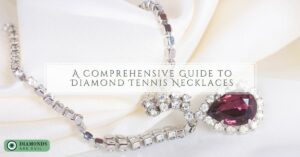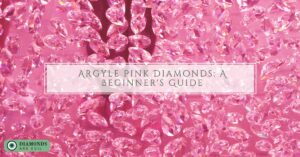The evolution of growing diamonds in laboratories came up in the 1950s by the scientist. Diamonds created during this period were found to be insignificant in terms of their size, but in the years the 1990s, production of larger gemstones began, which were found to be of better quality.
The production of quality diamonds has continued to date, and more gemology labs have been created to aid in massive production of it. Synthetic diamonds are now grown in several countries for various purposes, such as industrial and ornamental.
How real a lab-grown diamond can be
Lab diamonds are as real and of quality as the ones mined from the earth. They possess similar chemical and visual properties just as natural diamonds despite the fact that they are grown by scientists. Sometimes, expert gemologists find it confusing to differentiate between a lab diamond and the natural diamond merely by looking at it.
When the idea of growing diamonds in the lab was considered and then first implemented, gemologists could only grow diamonds in small sizes, but as time passed on, there came a way of growing larger diamonds. In recent times, diamonds can be as large as over 3 carats.
The source from which a piece of diamond came out can actually be guessed out when putting into consideration their shapes. Lab-grown diamond usually comes in varying shapes, which include oval, pear, radiant, marquise, emerald, Asscher, and princess. Apart from the shape of the stone, color grades can also be used to deduce if a piece of diamond was mined from its natural source or grown in a laboratory.
Most diamonds grown by gemologists are usually characterized by various colors. Examples of these shades of colors are; blue, pink, yellow, and orange. A report from the Gemological Institute of America, by Stephen Morisseau, a spokesperson for the nonprofit organization that manages the international diamond grading system, posits that Lab-created diamonds are as original as diamonds mined naturally.
Although not cubic zirconias as in the case of natural diamonds. Occasionally, lab-created diamonds are denoted as synthetic or imitation diamonds. Though this assertion is not technically inaccurate, the term “synthetic” may serve as the reason why customers that buy gemstones believe lab-created diamonds are “counterfeit”. For a while instantly, there has been a lot of debate regarding how to identify a lab-created, and to ascertain whether it is as real as diamonds mined from the earth.
Choosing to go for lab-created diamonds is a decision based on personal preference; sometimes, diamond buyers may think that lab-grown diamonds are not as clear as the naturally mined diamonds; this thought is absolutely incorrect. One of the numerous advantages of lab-grown diamonds is that they can be made into desired colors as requested by customers.
Colored diamonds are achieved by effecting changes in the carbon gas mix added to the Chemical Vapor Deposition reactor combined with treatments applied to gemstones at the end of the combination process. The resulting diamond is then made obtainable in shades of pink and powder blue coloration. As simple as this creation process sounds, it takes gem scientists several thousand hours to come up to perfection.
Facts about lab-grown diamonds
- Theoretically, there is no restriction to how diamonds can be grown in the lab. The lengthier they get, the bigger they grow, but at present, the biggest lab-created diamond ever made is about 155 carats.
- It has been estimated that Lab-made diamond retails for about 20%-40%, which aggregates for a 30% reduction in price than a mined diamond. The difference in price alone wins the heart of many consumers, thereby making consumers prefer lab-created diamonds.
- Lab-made diamonds are also endorsed as being a more humane and eco-friendly choice, devoid of the cases of blood diamonds or the hazard that comes with mining.
- A similarity between Laboratory grown diamonds and the natural diamonds is that both consist of unpolluted carbon in a cubic crystalline form, howbeit, to easily identify a lab-created diamond, several other differences are available to contrast.
Regardless of how much irregular and raw diamonds are unearthed from mines, there is a specific amount as to how several diamonds are produced over 1-carat weight. For instance, Lab-grown diamonds are produced depending on orders gotten from customers. These orders can account for the physical attributes a diamond can possess. Criteria such as what size, clarity, and shape and carat can be customized by a gemologist and a lab will produce it. This sort of attribute is difficult to give to diamonds that come naturally from the earth.
An important aspect of marketing lab-grown diamonds is the terminology implored. The guiding principles by Diamond Producers Association posit that the industry should possibly avoid the use of terms such as real, genuine, and authentic when describing lab-made diamonds because it still doesn’t strike a difference between it and the earthly mined diamonds. Diamond-growing labs do not encourage the use of terminology such as “natural”. Applying the word natural as a synonym for a mined diamond can only suggest that the lab-grown diamonds are not authentic and are imitations of the mined diamonds just like moissanite.
In the process of creating diamonds, both the lab diamonds and the earth mined diamonds use the same elements of nature, which is carbon. And at both procedures of creation or mining, both require high pressure and intense heat. Jean-Marc Lieberherr, Chief Executive Officer of Diamond Producers Association, of opinion believes that diamonds created in labs are not diamonds at all. In a boastful piece, he inferred by saying, “Just as it is impossible to compare an original painting to a replica, so is it not possible to compare a diamond to a factory-made replica”.
Bottom-line; a trained gemologist can easily identify a CVD grown type of diamond simply by making use of a standard gemology testing tool. In some other cases, it could require the use of advanced scientific equipment. There are several other methods that can be used to identify diamonds, all of which are dependent on the geological study of its properties.
To end with, lad-created diamonds grown through the High Pressure and High-Temperature technique regularly have a trace amount of elements such as Nickel and Iron in them usually with a cluster of tiny pin-prick inclusions. Inclusions are sometimes sufficient to attract forces from a magnet. A remote method that can work for you as a user of a diamond is to get a strong Neodymium magnet to obtain the best result. Neodymium magnet is available for sale in most hardware stores; if not, they can also be ordered online from websites like amazon.
You can verify for magnetic attractions in diamonds using two ways. One of which is to touch the magnet directly to the diamond and find out whether the gem can be lifted off the surface that it is resting on. Once the metallic inclusions of Nickel and Iron are located, there will be a strong pull on the magnet. Therefore one might have to try several parts of the diamond to get an attraction. If getting an attraction seems difficult, one might have to test each diamond as a loose stone, rather than testing it in the cluster






